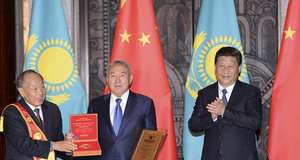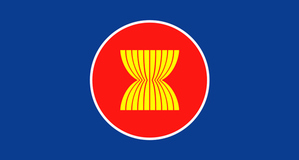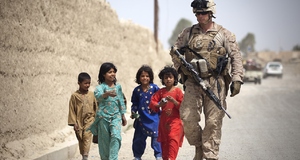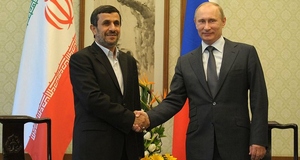|
From Cornell International Affairs Review VOL. 8 NO. 2 Surveying the Challenges and Opportunities of America's Foreign Policy Toward Central Asia
By Andreas Borgeas
Cornell International Affairs Review
2015, Vol. 8 No. 2 | pg. 2/3 | « »
Beyond the internal issues facing each republic, a number of regional challenges exist that compromise stability efforts in Central Asia. Many of these regional challenges include border disputes, natural resource conflicts, ethnic minority mistreatment, drug trafficking and terrorism. Uzbekistan, for example, shares borders with four neighbors and is often at the center of regional disputes, by either its own actions or those of organizations such as the Islamic Movement of Uzbekistan (IMU), a terrorist organization which aims to topple the Uzbek government and is known to operate within the neighboring republics.
The worst problem of ethnic violence in the region has been between Kyrgyz and ethnicUzbeks in southern Kyrgyzstan near the Uzbek border. In June 2010 violent clashes reportedly resulted in 470 deaths with nearly 2,000 injured. Most of these casualties were considered ethnic Uzbeks. While Uzbekistan did not become involved in the fighting it did host over 100,000 Uzbek refugees on a temporary basis. As a result of this violence, the IMU vowed retaliation against the Kyrgyz government and has successfully recruited ethnic Uzbeks from southern Kyrgyzstan to join their movement. Both countries blame the other for harboring terrorists. Since 2010 gunfire and violence at the Kyrgyz-Uzbek border have resulted in tighter border crossings and a movement by the Uzbek government to seal and mine large portions of the border regions.
Tajikistan and Kazakhstan have also experienced reported terrorist attacks in their respective countries from perpetrators with links to the IMU and other Islamic extremist groups. In 2003 Kazakhstan established the Anti-Terrorist Center as part of its National Security Committee and claims to have convicted over 300 people of terrorism since 2005. The 2010 terrorist attacks in Tajikistan, including a suicide car bombing and attack on a military convoy, have also been linked to the IMU Uzbekistan itself has been accused of bombing the Tajik Supreme Court building in an effort to overthrow the Tajik government.
Tajikistan also faces substantial threats from terrorism and drug trafficking activities arising out of Afghanistan, which have resulted in instability in the shared mountainous Badakhshan region. This region is a major transit corridor for drugs and other illicit goods smuggled into Tajikistan as well as weapons and financing being sent into Afghanistan. Making matters worse the Tajik government lacks the resources to properly secure the border, and border agents themselves have been reportedly participating in the trafficking enterprises. The Tajik government is also concerned about ethnic violence towards several million Tajiks in Afghanistan and the nearly one million Tajiks living in Uzbekistan.
Regional tensions are further exacerbated by the “water wars” between Uzbekistan and Kyrgyzstan, Uzbekistan and Tajikistan and – to a lesser extent – with Turkmenistan. In an effort to min- imize its energy shortages, Kyrgyzstan plans to build a hydroelectric power plant on the Naryn River despite fierce opposition by Uzbekistan, which claims that such a project will restrict its own water supply. Similarly, Tajikistan would like to build a dam for its own power plant on the Vakhsh River but it too faces Uzbek opposition on grounds it will alter the environment and harmUzbekistan’s agricultural industries. In political brinksmanship, the Uzbek government restricted railway and road access to Tajikistan, boosted rail tariffs and cutoff gas supplies. The international community has proposed a water-for-gas trade between the countries but so far this idea has not been successful.
Turkmenistan has had the least amount of strife with Uzbekistan. However, it too has had tension with Uzbekistan regarding water sharing and accusations of regional interference, accusing Uzbekistan of attemptingto orchestrate a political coup in 2002. Another regional challenge is the border dispute in the Soviet apportioned Fergana Valley, with Uzbekistan, Kyrgyzstan, and Tajikistan each vying for geographic control and regional influence in this Islamic heartland.
Each Central Asian republic has aspirations extending beyond the US withdrawal, and they invariably include lucrative relations with Russia and China. Both Russia and China have established military alliances to secure against Islamic extremism and post U.S. withdrawal instability, oil and gas pipelines, trade links for commercial goods, and strategic partnerships to extend their respective influence. China also has acute security interests in the Xinjiang region near the Kazakh and Kyrgyz borders where ethnic Uighurs are considered a substantial security risk. While population numbers remain disputed, it is estimated over 350,000 Uighurs live in Kazakhstan and Kyrgyzstan. Security disputes and accusations of mistreatment have at times caused tense relations between these neighboring nations. The Central Asian countries, with the exception of Turkmenistan, belong to both the Shanghai Cooperation Organization (SCO) and the Collective Security Treaty Organization (CSTO). The SCO includes China and Russia and focuses on security and combating terrorism. The CSTO, however, is anchored by Russia only and is intended to provide military support to CSTO members in prevention of outside aggression. The CSTO requires members to obtain CSTO permission before it can host a foreign military bases. Perceiving the treaty terms as excessively interfering with its sovereignty, Uzbekistan suspended its membership from the CSTO in 2012.
The Central Asian countries have not focused their interests exclusively on Russia and China. All five states are members of the Organization for Security and Cooperation in Europe (OSCE), which has fifty-seven member states from Europe, Central Asia, and North America. The OSCE’s focus is on security, democracy, human rights, economic development and integration, and environmentalism. Recent OSCE agendas have included promoting stability in Afghanistan and encouraging economic integration between Afghanistan and Central Asia. Additionally, all five countries are members of NATO’s Partnership for Peace and participate in Annual Bilateral Consultations with the US. These groups provide a forum for high level discussions on political and economic matters. On the economic side, Kyrgyzstan joined the World Trade Organization (WTO) in 1998, and Kazakhstan is expected to join in 2015 followed sometime thereafter by Tajikistan. While still in its formative stage, Russia and Kazakhstan are working to formallyestablish the Eurasian Economic Union by 2015. This economic trade zone will likely seek to include the other nations of Central Asia.
Each nation has also made known its own policy goals for beyond 2015. As identified in the Strategy Kazakhstan 2050, Kazakhstan’s priorities are upgrading and diversifying its energy infrastructure, promoting regional security, attracting foreign direct investment and strengthening the Customs Union to establish the Eurasian Economic Union . In addition, Kazakhstan will maintain its existing multi-vectored approach toward economic, security and political relations with Russia, China and the United States.
Kyrgyzstan aims to fight internal corruption and attract FDI to repair and upgrade its electrical system and agricultural infrastructure. It also supports a new railway proposed by China through Kyrgyzstan to Uzbekistan and another north-south railway. Kyrgyzstan currently leads Central Asia in the privatization of business and industry and would also like to continue to encourage foreign capital and investment.
Both Kyrgyzstan and Tajikistan are seeking foreign investment to expand their hydroelectric stations that would accommodate sales in Afghanistan and Pakistan. Additionally, Tajikistan has agreed to cooperate with Afghanistan and Iran to build rail, electric, and water pipeline links for greater regional opportunities. Other major goals for Tajikistan include battling drug trafficking, organized crime, and terrorism. This includes encouraging regional cooperation and strengthening security in Central Asia. Additionally Tajikistan claims to have put forth a new effort to target government officials and authorities involved in drug trafficking.
One of Uzbekistan’s political objectives is strengthening its regional influence amongst the republics, maneuvering against heavyweight Kazakhstan, and limiting interference in Central Asia from outside influences, especially Russia. This includes expanding its own hydroelectric facilities to prevent Tajikistan and Kyrgyzstan from expanding their facilities and weakening Uzbekistan’s position in the region.
While Turkmenistan has significant cultural and economic ties with Iran, one of its stated goals in 2011 was to diversify gas routes via a trans-Caspian pipeline in hopes of accessing European markets. Additionally, it has agreed to construct the TAPI pipeline pending financing that will connect Turkmenistan to Afghanistan, Pakistan and India.Continued on Next Page »
Endnotes
- US Embassy, Bishkek, Kyrgyzstan, Transit Center at Manas: Recent US Contributions to the Kyrgyz Government and Economy, October, 2014, http://bishkek.usembassy.gov/tc_re cent_contributions.html; US Embassy, Bishkek, Kyrgyzstan, Transit Center Jet Fuel Con tracts 2009-2011, October 27 2011, http://bishkek.usembassy.gov/fuel_contracts.html.
- US Overseas Loans and Grants, http://gbk.eads.usaidallnet.gov/docs/tables/agency/us aid_10000010100001_0111.xls.
- Ibid
- U.S Aid, Foreign Assistance Database (FADB) http://gbk.eads.usaidallnet.gov.
- Ibid. (Data for 2012 indicates a significant increase in payments of US foreign aid to both Kyr- gyzstan and Uzbekistan, however, these fluctuations can be attributed to the pullout of US troops and materials from Central Asia) [2012 (in millions) – Kazakhstan: 75.97, Kyrgyzstan: 76.55, Tajikistan: 36.63, Turkmenistan: 11.87, Uzbekistan: 34.43]; see also Congressional Budget Justi- fication FY2013-2015 located at http://www.state.gov/s/d/rm/rls/ebs/2015/ for trends that indicate substantial reductions in US foreign assistance (for example, aid to Kazakhstan and Tajikistan decreased 31% and 27% respectively from FY2013-15).
- China and Russia Reach 30-Year Gas Deal, by Jane Perlez, New York Times, May 21, 2014, http://www.nytimes.com/2014/05/22/world/asia/china-russia-gas-deal.html.
- US Department of Commerce, Census Bureau, Foreign Trade: Country and Product Trade Data, http://www.census.gov/foreign-trade/statistics/country/.
- US House of Representatives, US Policy in Central Asia: Hearing Before the Subcommittee on Europe and Eurasia, 112 Congress 2nd sess., 2012, 53.
- U.S Aid, Foreign Assistance Database (FADB) http://gbk.eads.usaidallnet.gov.
- U.S. Library of Congress, Congressional Research Service. Kazakhstan: Recent Developments and U.S. Interests, by Jim Nichol, CRS Report 97-1058, August 10, 2012.
- U.S. Library of Congress, Congressional Research Service. Kyrgyzstan: Recent Developments and U.S Interests, by Jim Nichol, CRS Report 97-690, October 26, 2012. Also see U.S. Department of State, Congressional Budget Justification for Foreign Operations for FY2013, Annex: Regional Perspectives, April 3, 2012, http://www.state.gov/documents/ organization/185015.pdf.
- U.S. Department of State, International Narcotics Control Strategy Report, Volume I: Drug and Chemical Control, March 2013.
- International Institute of Strategic Studies, The Military Balance, March 7, 2012; Uzbekistan: Where Conscripts Are Eager to Serve, EurasiaNet, http://www.eurasianet.org/node/65411.
- U.S. Ends Ban on Aid to Uzbekistan, by Nathan Hodge, Wall Street Journal, February 1, 2012. Also, As Uzbekistan’s Utility to U.S Drops, Military Aid Bolstered, by Joshua Kucera, Eurasianet, February 11, 2012, http://www.eurasianet.org/node/68029.
- Ibid
- U.S. Department of State, Congressional Budget Justification for Foreign Operations for FY2013, Annex: Regional Perspectives, April 3, 2012, http://www.state.gov/documents/organiza- tions/185015.pdf.
- U.S. Department of State, Country Reports on Human Rights Practices for 2012: Kazakhstan,http://www.state.gov/j/drl/rls/hrrpt/humanrightsreport/index.htm?year=2012&dlid=204402.
- U.S. Department of State, Trafficking in Persons Report, June 19, 2012.
- Press Release: Agreement Reached with Republic of Kazakhstan on Karachaganak, BG Group, December 14, 2011, http:// bg-group.com/MEDIACENTRE/PRESS/Pages/14Dec2010.aspx.
- The White House, Office of the Press Secretary, Statement by President Obama on the Parliamen- tary Elections in Kyrgyzstan, October 11, 2010.
- U.S. Department of State, 2011 Human Rights Report Kyrgyz Republic, http://www.state.gov/j/ drl/rls/hrrpt/2011/sca/186468.htm.
- Central Intelligence Agency, World Fact Book: Kyrgyzstan, https://www.cia.gov/library/publica- tions/the-world-factbook/geos/kg.html.
- OSCE, Office for Democratic Institutions and Human Rights, Final Report on the 6 November 2006 Presidential Elections in Tajikistan, April 18, 2007, http://www.osce.org/odihr/elections/tajik- istan/24664.
- Institute for War and Peace Reporting, Emerging Force in Tajik Politics Arrested, by Abdumalik Kadirov, May 20, 2013, http://iwpr.net/report-news/emerging-force-tajik-politics-arrested.
- Human Rights Watch, World Report 2013, http://www.hrw.org/world-report/2013/country-chapters/tajikistan?page=1.
- US Commission on International Religious Freedom, Annual Report 2012, by Leonard A. Leo, Dr. Don Argue, Dr. Elizabeth H. Prodromou, et al., Washington D.C United States GPO, 2012.
- US Commission on International Religious Freedom, 2011 Report on International Religious Freedom – Tajikistan, Washington D.C. United States GPO, July 30, 2012.
- Addicted: Heroin Stabilizes a Poor Country, The Economist, April 21, 2012, http://www.economist.com/node/21553092.
- Freedom House, The Worst of the Worst: The World’s Most Repressive Societies 2012, http:// http://www.freedomhouse.org/report/special-reports/worst-worst-2012-worlds-most-repressive-societ- ies#.U1rtNRXD9aT.
- European Union, Uzbekistan: EU Counsel Adopts Restrictive Measures, November 14, 2005,
http://www.eu-un.europa.eu/home/print/asp?1=1&1g=5.
- US Commission on International Religious Freedom, Annual Report, March 2012.
- U.S. Library of Congress, Congressional Research Service. Uzbekistan: Recent Developments and U.S. Interests, by Jim Nichol, CRS Report RS21238, August 3, 2012.
- Freedom House, The Worst of the Worst: The World’s Most Repressive Societies 2012, http:// http://www.freedomhouse.org/report/special-reports/worst-worst-2012-worlds-most-repressive-societ- ies#.U1rtNRXD9aT.
- US Department of State, Country Reports on Human Rights Practices for 2011, May 24, 2012, http://www.state.gov/j/drl/rls/hrrpt/2011humanrightsreport/index.htm?dynamic_load_ id=186163#wrapper.
- US Department of State, Turkmenistan: 2012 Investment Climate Statement, February 16, 2012, http://www.state.gov/e/eb/rls/othr/ics/2012/191255.htm.
- Field Research in Osh, Kyrgyzstan and Andijon, Uzbekistan (notes and confidential interviews on file with author)(June 2014)
- UNHCR, Final Report on UNHCR Emergency Operations in the Republic of Uzbekistan, July 23, 2010, http://www.unhcr.org/4c51717a6.pdf.
- Fresh Border Incidents Underscore Unresolved Problems in Fergana Valley, by Igor Rotar, Eurasia Daily Monitor, Volume: 9, Issue: 172, September 21, 2012, https://www.ecoi.net/local_ link/231205/339664_en.html.
- U.S. Library of Congress, Congressional Research Service. Kazakhstan: Recent Developments and U.S. Interests, by Jim Nichol, CRS Report 97-1058 (Washington, DC: Office of Congressional Information and Publishing, July 22, 2013).
- Stratfor Global Intelligence, The Tajikistan Attacks and Islamist Militancy in Central Asia, by Ben West, September 23, 2010, http://www.stratfor.com/weekly/20100922_tajikistan_attacks_ and_islamist_militancy_central_asia. Uzbek Security Services Accused of Explosions at Tajik Supreme Court, Fergana News, July 16, 2008, http://enews.fergananews.com/news.php?id=504&print=1.
- U.S. Department of State, Country Reports on Terrorism 2011, July 31, 2012.
- U.S. Library of Congress, Congressional Research Service. Tajikistan: Recent Developments and U.S. Interests, by Jim Nichol, CRS Report 98-594, August 31, 2012.
- Uyghur, by Irene Thompson, World Languages, http://aboutworldlanguages.com/Uyghur.
- Kyrgyzstan Says Kills 11 Uighur Militants Near Chinese Border, by Olga Dzyubenko, Reuters, January 24, 2014,http://www.reuters.com/article/2014/01/24/us-kyrgyzstan-uighurs-idUSBREA0N0MT20140124.
- Organization for Security and Cooperation in Europe, Regional Economic Integration in South and Central Asia, by Geoffrey Pratt, March 12, 2013.
- Kazakhstan’s WTO Accession, A Long Winding Road It May Be But Hope Remains Strong, by Sara Rajabova, AZERNEWS, February 26, 2015, http://www.azernews.az/analysis/78278.html.
- Russia, Kazakhstan and Belarus Form Eurasian Economic Union, by Abigail Hauslohmer, Wash- ington Post, May 29, 2014, http://www.washingtonpost.com/world/europe/russia-kazakhstan-be- larus-form-eurasian-economic-union/2014/05/29/de4a2c15-cb01-4c25-9bd6-7d5ac9e466fd_story. html.
- Kazakhstan Foreign Policy Concept for 2014, by Gulay Mutlu, Eurasia Review, http://www.eurasiareview.com/21032014-kazakhstan-foreign-policy-concept-for-2014-2020-and- ukraine-crisis-analysis/.
- U.S. Library of Congress, Congressional Resource Service. Kyrgyzstan: Recent Developments and U.S. Interests, by Jim Nichol, CRS Report 97-690, October 26, 2012.
- U.S. Department of State, International Narcotics Control Strategy Report, Volume 1: Drug and Chemical Control, March 2012.
- The United States and Central Asia after 2014, by Jeffrey Mankoff, Center for Strategic and International Studies, January 2013.
- “President’s Welcoming Address,” Turkmenistan: The Golden Age, March 3, 2011, http://turk-
menistan.gov.tm/_en/?idr=4&id=110303a.
- Interview of First Secretary, Political Section Chief, U.S. Embassy in Bishkek, Kyrgyzstan (notes and confidential interviews on file with author) (June 2014)
- Political Islam in Central Asia: The Challenge of Hizb ut-Tahrir, by Emmanuel Karagiannis, Routlege 2010.
- Counterterrorism Policies in Central Asia, by Mariya Y. Omelicheva, Routledge 2011.
- Islam and Democracy: Can Islamic Institutions Promote Civil Liberties and Diminish Radicalism in Muslim Central Asia?, by Dilshod Achilov, IREX Research Report 2009.
- Jihad: The Rise of Militant Islam in Central Asia, by Ahmed Rashid, Yale University Press 2002.
Notes
[i] For purposes of this article Central Asia includes the Republics of Kazakhstan, Kyrgyzstan, Tajikistan, Turkmenistan and Uzbekistan.
[ii] An earlier version of this article was originally published as America’s Managed (Dis)Engage- ment Policy Toward Central Asia in the Journal of Diplomacy and International Relations (Vol. XV, Summer 2014).
[iii] Portions of this recommendation section were originally published in the following articles: Islamic Militancy and the Uighur of Kazakhstan, by Andreas Borgeas, Yale Journal of International Affairs, Winter 2013; Security Relations Between Kazakhstan and China: Assessments and Recommendations on the Transnational Uighur Question, by Andreas Borgeas, Columbia Journal of International Affairs, April 10, 2013
[iv] Proposing a “western flank” of America’s so-called pivot policy toward Asia is premised on the intuitive engagement agenda whereby the US endeavors to improve political, military and economic relations with those countries surrounding China and are foreseeably within its futuresphere of influence. See Obama Heads to India to Revive ‘Pivot to Asia Policy by Christi Parsons and Shashank Bengali, LA Times, January 24, 2015. While such a policy has had punctuated developments (i.e. normalizing relations with Myanmar, expanding the ASEAN Free Trade Area, efforts to curb the Asian Infrastructure Investment Bank and an assortment of new military policies), it remains unclear whether the proposed policy is more of a directional rebalancing as opposed to a formal policy of Chinese containment. See What Exactly Does it Mean that the U.S. is Pivoting to Asia? And Will it Last?, by Matt Schiavenza, The Atlantic, April 15, 2013; see also Why the US Effort to Curb the Asian Infrastructure Investment Bank Will Fail, by Erik Voeten, Washington Post, March 19, 2015.The notion put forward in this article is that the Cen- tral Asia Republics would appear to be natural candidates under this pivot agenda for enhanced relations with the US.
Save Citation » (Works with EndNote, ProCite, & Reference Manager)
APA 6th
Borgeas, A. (2015). "Surveying the Challenges and Opportunities of America's Foreign Policy Toward Central Asia." Cornell International Affairs Review, 8(2). Retrieved from http://www.inquiriesjournal.com/a?id=1178
MLA
Borgeas, Andreas. "Surveying the Challenges and Opportunities of America's Foreign Policy Toward Central Asia." Cornell International Affairs Review 8.2 (2015). <http://www.inquiriesjournal.com/a?id=1178>
Chicago 16th
Borgeas, Andreas. 2015. Surveying the Challenges and Opportunities of America's Foreign Policy Toward Central Asia. Cornell International Affairs Review 8 (2), http://www.inquiriesjournal.com/a?id=1178
Harvard
BORGEAS, A. 2015. Surveying the Challenges and Opportunities of America's Foreign Policy Toward Central Asia. Cornell International Affairs Review [Online], 8. Available: http://www.inquiriesjournal.com/a?id=1178
Suggested Reading from Inquiries Journal
The New Silk Road, formally termed the Silk Road Economic Belt and also known as the "One Belt, One Road," was first proposed by China's President Xi Jinping during his 2013 visit to Central Asia. This initiative aims to revive the historical vitality of trade and exchanges among Central Asian countries and China.1 The vision of... MORE»
Regionalism, as Edward Mansfield describes, usually involves policy coordination through formal institutions within a region.1 Although there are conceptual debates surrounding what a region is and what regionalism is, empirically... MORE»
Nearly eight years into the war, the security situation in Afghanistan appears to be deteriorating at an increasingly fast past. Areas that were previously secured have been retaken by militants; significant increases in civilian casualties, caused primarily by U.S.-led attacks, have fostered a growing resentment within the civilian... MORE»
Russia and Iran have a long history of being geographic neighbours, rivals, competitors and partners - a history which has coined mutual expectations, stereotypes and interactions. Still present in the Iranian collective... MORE»
Latest in Political Science
2022, Vol. 14 No. 09
This interdisciplinary paper investigates the shortfalls and obstacles to success currently facing the climate movement, examining issues represented by the disconnect between policy and electoral politics, the hypocrisy and blatant indifference... Read Article »
2022, Vol. 14 No. 06
Two of the most prevalent protest movements in recent history were the Black Lives Matter and the #StopTheSteal movements. While there are many differences between the two, one of the most prevalent is their use of violence. Whereas the BLM movement... Read Article »
2022, Vol. 14 No. 05
Strong linkages between autocrats and the military are often seen as a necessary condition for authoritarian regime survival in the face of uprising. The Arab Spring of 2011 supports this contention: the armed forces in Libya and Syria suppressed... Read Article »
2022, Vol. 14 No. 04
During the summer of 2020, two fatal shootings occurred following Black Lives Matter protests. The first event involved Kyle Rittenhouse in Kenosha, Wisconsin, and the second Michael Reinoehl in Portland, Oregon. Two shootings, each committed by... Read Article »
2022, Vol. 14 No. 02
In popular international relations (IR) theory, knowledge production is often dismissed as an objective process between the researcher and the empirical world. This article rejects this notion and contends that the process of knowledge production... Read Article »
2022, Vol. 14 No. 01
This article explores the political relationship between nation-building, ethnicity, and democracy in the context of Ethiopia. It traces Ethiopia's poltical history, explores the consequential role ethnicity has played in the formation of the modern... Read Article »
2022, Vol. 14 No. 01
The study examines the degree to which Xi Jinping has brought about a strategic shift to the Chinese outward investment pattern and how this may present significant political leverage and military advantages for China in the Indian Ocean Region (... Read Article »
|




















